formerly eScholarship Editions


|
|
|
|
Your request for similar items found 20 book(s). | Modify Search | Displaying 1 - 20 of 20 book(s) | |
| 1. | 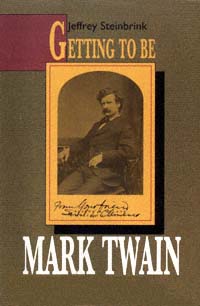 | Title: Getting to be Mark Twain Author: Steinbrink, Jeffrey Published: University of California Press, 1991 Subjects: Literature | American Literature | Literary Theory and Criticism Publisher's Description: Mark Twain is one of our most accessible cultural icons, a figure familiar to virtually every American and renowned internationally. But he was not always as we know him today. Mark Twain began life as a loose gathering of postures, attitudes, and voices in the mind of Samuel Clemens. It was some time before he took full possession of the personality the world now recognizes.This is the story of the coming of age of Mark Twain. It begins in 1867, with Clemens stepping off the steamship Quaker City and almost immediately declaring himself "in a fidget to move." It comes to a close in 1871, with Clemens settling in Hartford. Mark Twain was substantially formed during the intervening years, as Clemens came East, gained fame and fortune with the publication of Innocents Abroad , courted and married Olivia Langdon, and established himself as a professional writer. Each of these steps represented a profound change in the former Wild Humorist of the Pacific Slope as he sifted through the elements in his personality and began to assume the qualities we now associate with him. The tale that unfolds here shows how, through that process, the Mark Twain of the late 1860s became the Mark Twain of all time. [brief] Similar Items |
| 2. | 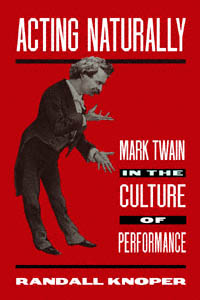 | Title: Acting naturally: Mark Twain in the culture of performance Author: Knoper, Randall K 1953- Published: University of California Press, 1995 Subjects: Literature | American Literature | Literary Theory and Criticism | Twain | American Studies Publisher's Description: The phenomenon of performance is central to Mark Twain's writing and persona. But Twain's performative aspects have usually been dismissed as theatrical and discounted as lowbrow burlesque. Randall Knoper takes Twain's theatricality seriously and shows how Twain's work both echoes and engages the social and cultural problems embodied in nineteenth-century popular entertainments.Knoper draws on theater history, theories of acting and bodily expression, psychology and physiology, scientific accounts of spiritualism, and commercial spectacles to demonstrate Twain's use of "acting" and the "natural" in his creative explorations. This book enlarges our understanding of Mark Twain - the artist and the man - and also provides a window into a culture whose entertainments registered the sexual, racial, economic, and scientific forces that were transforming it. [brief] Similar Items |
| 3. | 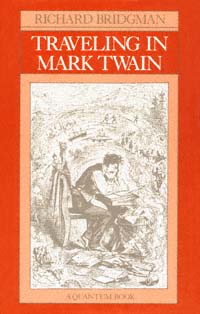 | Title: Traveling in Mark Twain Author: Bridgman, Richard Published: University of California Press, 1987 Subjects: Literature | English Literature | American Literature Similar Items |
| 4. | 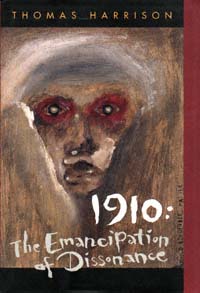 | Title: 1910, the emancipation of dissonance Author: Harrison, Thomas J 1955- Published: University of California Press, 1996 Subjects: Literature | Comparative Literature | European Literature | Art History Publisher's Description: The year 1910 marks an astonishing, and largely unrecognized, juncture in Western history. In this perceptive interdisciplinary analysis, Thomas Harrison addresses the extraordinary intellectual achievement of the time. Focusing on the cultural climate of Middle Europe and paying particular attention to the life and work of Carlo Michelstaedter, he deftly portrays the reciprocal implications of different discourses - philosophy, literature, sociology, music, and painting. His beautifully balanced and deeply informed study provides a new, wider, and more ambitious definition of expressionism and shows the significance of this movement in shaping the artistic and intellectual mood of the age. 1910 probes the recurrent themes and obsessions in the work of intellectuals as diverse as Egon Schiele, Georg Trakl, Vasily Kandinsky, Georg Lukàcs, Georg Simmel, Dino Campana, and Arnold Schoenberg. Together with Michelstaedter, who committed suicide in 1910 at the age of 23, these thinkers shared the essential concerns of expressionism: a sense of irresolvable conflict in human existence, the philosophical status of death, and a quest for the nature of human subjectivity. Expressionism, Harrison argues provocatively, was a last, desperate attempt by the intelligentsia to defend some of the most venerable assumptions of European culture. This ideological desperation, he claims, was more than a spiritual prelude to World War I: it was an unheeded, prophetic critique. [brief] Similar Items |
| 5. | 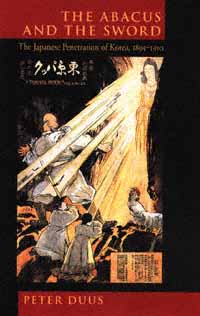 | Title: The abacus and the sword: the Japanese penetration of Korea, 1895-1910 Author: Duus, Peter 1933- Published: University of California Press, 1995 Subjects: History | Asian History | Asian Studies | Japan | East Asia Other Publisher's Description: What forces were behind Japan's emergence as the first non-Western colonial power at the turn of the twentieth century? Peter Duus brings a new perspective to Meiji expansionism in this pathbreaking study of Japan's acquisition of Korea, the largest of its colonial possessions. He shows how Japan's drive for empire was part of a larger goal to become the economic, diplomatic, and strategic equal of the Western countries who had imposed a humiliating treaty settlement on the country in the 1850s.Duus maintains that two separate but interlinked processes, one political/military and the other economic, propelled Japan's imperialism. Every attempt at increasing Japanese political influence licensed new opportunities for trade, and each new push for Japanese economic interests buttressed, and sometimes justified, further political advances. The sword was the servant of the abacus, the abacus the agent of the sword.While suggesting that Meiji imperialism shared much with the Western colonial expansion that provided both model and context, Duus also argues that it was "backward imperialism" shaped by a sense of inferiority vis-à-vis the West. Along with his detailed diplomatic and economic history, Duus offers a unique social history that illuminates the motivations and lifestyles of the overseas Japanese of the time, as well as the views that contemporary Japanese had of themselves and their fellow Asians. [brief] Similar Items |
| 6. | 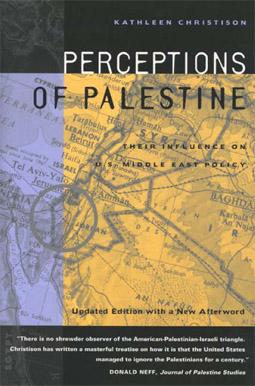 | Title: Perceptions of Palestine: their influence on U.S. Middle East policy Author: Christison, Kathleen 1941- Published: University of California Press, 1999 Subjects: Politics | Middle Eastern History | Middle Eastern Studies Publisher's Description: For most of the twentieth century, considered opinion in the United States regarding Palestine has favored the inherent right of Jews to exist in the Holy Land. That Palestinians, as a native population, could claim the same right has been largely ignored. Kathleen Christison's controversial new book shows how the endurance of such assumptions, along with America's singular focus on Israel and general ignorance of the Palestinian point of view, has impeded a resolution to the Arab-Israeli conflict. Christison begins with the derogatory images of Arabs purveyed by Western travelers to the Middle East in the nineteenth century, including Mark Twain, who wrote that Palestine's inhabitants were "abject beggars by nature, instinct, and education." She demonstrates other elements that have influenced U.S. policymakers: American religious attitudes toward the Holy Land that legitimize the Jewish presence; sympathy for Jews derived from the Holocaust; a sense of cultural identity wherein Israelis are "like us" and Arabs distant aliens. She makes a forceful case that decades of negative portrayals of Palestinians have distorted U.S. policy, making it virtually impossible to promote resolutions based on equality and reciprocity between Palestinians and Israelis. Christison also challenges prevalent media images and emphasizes the importance of terminology: Two examples are the designation of who is a "terrorist" and the imposition of place names (which can pass judgment on ownership). Christison's thoughtful book raises a final disturbing question: If a broader frame of reference on the Palestinian-Israeli conflict had been employed, allowing a less warped public discourse, might not years of warfare have been avoided and steps toward peace achieved much earlier? [brief] Similar Items |
| 7. |  | Title: Slide Mountain, or, The folly of owning nature Author: Steinberg, Theodore 1961- Published: University of California Press, 1995 Subjects: Law | Environmental Studies | United States History | American Studies Publisher's Description: The drive to own the natural world in twentieth-century America seems virtually limitless. Signs of this national penchant for possessing nature are everywhere - from suburban picket fences to elaborate schemes to own underground water, clouds, even the ocean floor.Yet, as Theodore Steinberg demonstrates in this compelling, witty look at Americans' attempts to master the environment, nature continually turns these efforts into folly. In a rich, narrative style recalling the work of John McPhee, Steinberg tours America to explore some of the more unusual dilemmas that have arisen in our struggle to possess nature.Beginning along the Missouri River, Steinberg recounts the battle for three thousand acres of land the river carved from a Nebraska Indian reservation and deposited in Iowa. Then he travels to Louisiana, where an army of lawyers butted heads over whether Six Mile Lake was actually a lake or a stream. He continues to Arizona to investigate who owned the underground, then to Pennsylvania's Blue Ridge Mountains to see who claimed the clouds. He ends in crowded New York City with Donald Trump's struggle for air rights.Americans' obsession with owning nature was immortalized by Mark Twain in the tale of Slide Mountain, where a landslide-prone Nevada peak turned the American dream of real estate into dust. In relating these modern-day "Slide Mountain" stories, Steinberg illuminates what it means to live in a culture of property where everything must have an owner. [brief] Similar Items |
| 8. |  | Title: Dangerous emotions Author: Lingis, Alphonso 1933- Published: University of California Press, 2000 Subjects: Philosophy | Cultural Anthropology | Literature | Social and Political Thought | Travel Publisher's Description: Alphonso Lingis is an original among American philosophers. An eloquent and insightful commentator on continental philosophers, he is also a phenomenologist who has gone to live in many lands. Dangerous Emotions continues the line of inquiry begun in Abuses , taking the reader to Easter Island, Japan, Java, and Brazil as Lingis poses a new range of questions and brings his extraordinary descriptive skills to bear on innocence and the love of crime, the relationships of beauty with lust and of joy with violence and violation. He explores the religion of animals, the force in blessings and in curses. When the sphere of work and reason breaks down, and in catastrophic events we catch sight of cosmic time, our anxiety is mixed with exhilaration and ecstasy. More than acceptance of death, can philosophy understand joy in dying? Haunting and courageous, Lingis's writing has generated intense interest and debate among gender and cultural theorists as well as philosophers, and Dangerous Emotions is certain to introduce his work to an ever broader circle of readers. [brief] Similar Items |
| 9. | 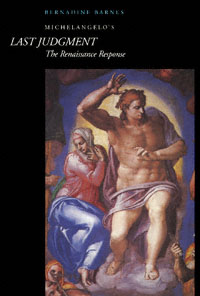 | Title: Michelangelo's Last Judgment: the Renaissance response Author: Barnes, Bernadine Ann Published: University of California Press, 1998 Subjects: Art Publisher's Description: In her analysis of Michelangelo's Last Judgment , Bernadine Barnes provides an original and stimulating view of this renowned fresco and of the audience for which it was created. Because Michelangelo is so often regarded as a nearly superhuman artistic genius, we tend to forget that his works were not created to illustrate his life. The Last Judgment did have great personal meaning for him, but his representation of this religious event was not purely self-directed, says Barnes. She argues that Michelangelo had a particular type of viewer in mind as he designed his work. The Last Judgment dealt with an especially evocative subject, and Michelangelo engaged viewers by creating highly imaginative scenes tempering fear with hope and by referring to contemporary events. The painting's original, elite audience - the papal court and a handful of distinguished lay persons - was sophisticated about art and poetry, almost exclusively male, and orthodox in its religious beliefs. That audience later broadened and included artists allowed into the Chapel to copy Michelangelo's work. These artists helped to create another, less sophisticated audience, one that knew the fresco only through reproductions and written descriptions. The response of this latter audience eventually prompted the church to censor the painting. Beautifully illustrated with photographs of the recently restored Sistine Chapel, Barnes's study greatly enhances our understanding of changing Renaissance attitudes toward art. Her book also provides valuable insights into one of Michelangelo's greatest works. [brief] Similar Items |
| 10. |  | Title: Authoritarian Argentina: the Nationalist movement, its history, and its impact Author: Rock, David 1945- Published: University of California Press, 1993 Subjects: History | Latin American Studies | Latin American History | Intellectual History Publisher's Description: David Rock has written the first comprehensive study of nationalism in Argentina, a fundamentalist movement pledged to violence and a dictatorship that came to a head with the notorious "disappearances" of the 1970s. This radical, right wing movement has had a profound impact on twentieth-century Ar . . . [more] Similar Items |
| 11. | 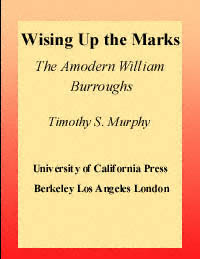 | Title: Wising up the marks: the modern William Burroughs Author: Murphy, Timothy S 1964- Published: University of California Press, 1998 Subjects: Literature | American Studies | Literary Theory and Criticism | Philosophy Publisher's Description: William S. Burroughs is one of the twentieth century's most visible, controversial, and baffling literary figures. In the first comprehensive study of the writer, Timothy S. Murphy places Burroughs in the company of the most significant intellectual minds of our time. In doing so, he gives us an immensely readable and convincing account of a man whose achievements continue to have a major influence on American art and culture. Murphy draws on the work of such philosophers as Gilles Deleuze, Félix Guattari, Theodor Adorno, and Jean-Paul Sartre, and also investigates the historical contexts from which Burroughs's writings arose.From the paranoid isolationism of the Cold War through the countercultural activism of the sixties to the resurgence of corporate and state control in the eighties, Burroughs's novels, films, and music hold a mirror to the American psyche. Murphy coins the term "amodernism" as a way to describe Burroughs's contested relationship to the canon while acknowledging the writer's explicit desire for a destruction of such systems of classification. Despite the popular mythology that surrounds Burroughs, his work has been largely excluded from the academy of American letters. Finally here is a book that presents a solid portrait of a major artistic innovator, a writer who combines aesthetics and politics and who can perform as anthropologist, social goad, or media icon, all with consummate skill. [brief] Similar Items |
| 12. | 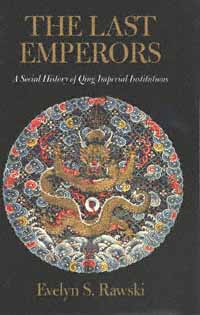 | Title: The last emperors: a social history of Qing imperial institutions Author: Rawski, Evelyn Sakakida Published: University of California Press, 1998 Subjects: History | Anthropology | China | Asian History Publisher's Description: The Qing Dynasty (1644-1911) was the last and arguably the greatest of the conquest dynasties to rule China. Its rulers, Manchus from the north, held power for three centuries despite major cultural and ideological differences with the Han majority. In this book, Evelyn Rawski offers a bold new interpretation of the remarkable success of this dynasty, arguing that it derived not from the assimilation of the dominant Chinese culture, as has previously been believed, but rather from an artful synthesis of Manchu leadership styles with Han Chinese policies. [brief] Similar Items |
| 13. | 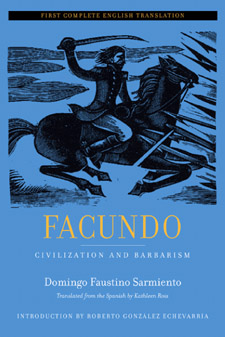 | Title: Facundo: civilization and barbarism: the first complete English translation Author: Sarmiento, Domingo Faustino 1811-1888 Published: University of California Press, 2004 Subjects: Literature | History | Latin American History | Politics | Literature in Translation Publisher's Description: A classic work of Latin American literature, Domingo Sarmiento's Facundo has become an integral part of the history, politics, and culture of Latin America since its first publication in 1845. Partially translated into English when it was first published, this foundational text appears here for the first time in its entirety. An educator and writer, Sarmiento was President of Argentina from 1868 to 1874. His Facundo is a study of the Argentine character, a prescription for the modernization of Latin America, and a protest against the tyranny of the government of Juan Manuel de Rosas (1835-1852). The book brings nineteenth-century Latin American history to life even as it raises questions still being debated today - questions regarding the "civilized" city versus the "barbaric" countryside, the treatment of indigenous and African populations, and the classically liberal plan of modernization. Facundo's celebrated and frequently anthologized portraits of the caudillo Juan Facundo Quiroga and other colorful characters give readers an exhilarating sense of Argentine culture in the making. Kathleen Ross's translation renders Sarmiento's passionate prose into English with all its richness intact, allowing the English-language reader the full experience of Facundo's intensity and historical reach. [brief] Similar Items |
| 14. | 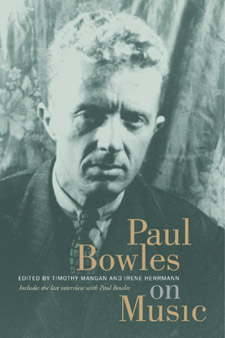 | Title: Paul Bowles on music Author: Bowles, Paul 1910- Published: University of California Press, 2003 Subjects: Music | American Music | Composers | Contemporary Music | American Literature | Film Publisher's Description: "It's an easy enough job if one has something to say," Paul Bowles remarked in a letter to his mother about his first foray into music criticism. And Paul Bowles, indeed, had plenty to say about music. Though known chiefly as a writer of novels and stories, Paul Bowles (1910-99) thought of himself first and foremost as a composer. Drawing together the work he did at the intersection of his two passions and professions, writing and music, this volume collects the music criticism Bowles published between 1935 and 1946 as well as an interview conducted by Irene Herrmann shortly before his death. An intimate of Aaron Copland and protégé of Virgil Thomson, Bowles was a musical sophisticate acquainted with an enormous range of music. His criticism collected here brilliantly illuminates not only the whole range of modernist composition but also film music, jazz, Mexican and Moroccan music, and many other genres. As a reviewer he reports on established artists and young hopefuls, symphonic concerts indoors and out, and important premieres of works by Copland, Thomson, Cage, Shostakovich, and Stravinsky, among others. Written with the austere grace of his better-known literary works, Bowles's criticism enhances our picture of an important era in American music history as well as our sense of his accomplishments and extraordinary contribution to twentieth-century culture. [brief] Similar Items |
| 15. | 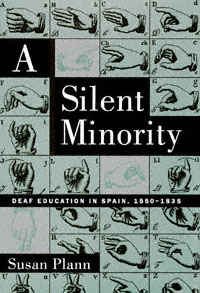 | Title: A silent minority: deaf education in Spain, 1550-1835 Author: Plann, Susan Published: University of California Press, 1997 Subjects: History | Language and Linguistics | Medieval History | European History | Education | European Studies | Medieval Studies | Cultural Anthropology | Cultural Anthropology Publisher's Description: This timely, important, and frequently dramatic story takes place in Spain, for the simple reason that Spain is where language was first systematically taught to the deaf. Instruction is thought to have begun in the mid-sixteenth century in Spanish monastic communities, where the monks under vows of silence employed a well-established system of signed communications. Early in the 1600s, deaf education entered the domain of private tutors, laymen with no use for manual signs who advocated oral instruction for their pupils. Deaf children were taught to speak and lip-read, and this form of deaf education, which has been the subject of controversy ever since, spread from Spain throughout the world.Plann shows how changing conceptions of deafness and language constantly influenced deaf instruction. Nineteenth-century advances brought new opportunities for deaf students, but at the end of what she calls the preprofessional era of deaf education, deaf people were disempowered because they were barred from the teaching profession. The Spanish deaf community to this day shows the effects of the exclusion of deaf teachers for the deaf.The questions raised by Plann's narrative extend well beyond the history of deaf education in Spain: they apply to other minority communities and deaf cultures around the world. At issue are the place of minority communities within the larger society and, ultimately, our tolerance for human diversity and cultural pluralism. [brief] Similar Items |
| 16. | 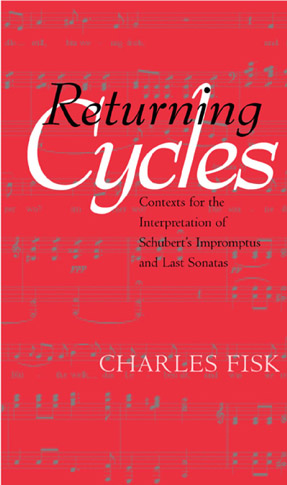 | Title: Returning cycles: contexts for the interpretation of Schubert's impromptus and last sonatas Author: Fisk, Charles Published: University of California Press, 2001 Subjects: Music | Musicology | Composers Publisher's Description: This compelling investigation of the later music of Franz Schubert explores the rich terrain of Schubert's impromptus and last piano sonatas. Drawing on the relationships between these pieces and Schubert's Winterreise song cycle, his earlier "Der Wanderer," the closely related "Unfinished" Symphony, and his story of exile and homecoming, "My Dream," Charles Fisk explains how Schubert's view of his own life may well have shaped his music in the years shortly before his death. Fisk's intimate portrayal of Schubert is based on evidence from the composer's own hand, both verbal (song texts and his written words) and musical (vocal and instrumental). Noting extraordinary aspects of tonality, structure, and gestural content, Fisk argues that through his music Schubert sought to alleviate his apparent sense of exile and his anticipation of early death. Fisk supports this view through close analyses of the cyclic connections within and between the works he explores, finding in them complex musical narratives that attempt to come to terms with mortality, alienation, hope, and desire. Fisk's knowledge of Schubert's life and music, together with his astute and imaginative attention to musical detail, helps him achieve one of the most difficult goals in music criticism: to capture and verbalize the human content of instrumental music. [brief] Similar Items |
| 17. |  | Title: Final judgments: duty and emotion in Roman wills, 200 B.C.-A.D. 250 Author: Champlin, Edward 1948- Published: University of California Press, 1991 Subjects: Classics | Ancient History Publisher's Description: Freed from the familial and social obligations incumbent on the living, the Roman testator could craft his will to be a literal "last judgment" on family, friends, and society. The Romans were fascinated by the contents of wills, believing the will to be a mirror of the testator's true character and opinions. The wills offer us a unique view of the individual Roman testator's world. Just as classicists, ancient historians, and legal historians will find a mine of information here, the general reader will be fascinated by the book's lively recounting of last testaments.Who were the testators and what were their motives? Why do family, kin, servants, friends, and community all figure in the will, and how are they treated? What sort of afterlife did the Romans anticipate? By examining wills, the book sets several issues in a new light, offering new interpretations of, or new insights into, subjects as diverse as captatio (inheritance-seeking), the structure of the Roman family, the manumission of slaves, public philanthropy, the afterlife and the relation of subject to emperor.Champlin's principal argument is that a strongly felt "duty of testacy" informed and guided most Romans, a duty to reward or punish all who were important to them, a duty which led them to write their wills early in life and to revise them frequently. [brief] Similar Items |
| 18. | 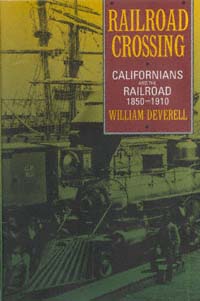 | Title: Railroad crossing: Californians and the railroad, 1850-1910 Author: Deverell, William Francis Published: University of California Press, 1994 Subjects: History | California and the West | United States History | Californian and Western History Publisher's Description: Nothing so changed nineteenth-century America as did the railroad. Growing up together, the iron horse and the young nation developed a fast friendship. Railroad Crossing is the story of what happened to that friendship, particularly in California, and it illuminates the chaos that was industrial America from the middle of the nineteenth century through the first decade of the twentieth.Americans clamored for the progress and prosperity that railroads would surely bring, and no railroad was more crucial for California than the transcontinental line linking East to West. With Gold Rush prosperity fading, Californians looked to the railroad as the state's new savior. But social upheaval and economic disruption came down the tracks along with growth and opportunity.Analyzing the changes wrought by the railroad, William Deverell reveals the contradictory roles that technology and industrial capitalism played in the lives of Americans. That contrast was especially apparent in California, where the gigantic corporate "Octopus" - the Southern Pacific Railroad - held near-monopoly status. The state's largest employer and biggest corporation, the S.P. was a key provider of jobs and transportation - and wielder of tremendous political and financial clout.Deverell's lively study is peopled by a rich and disparate cast: railroad barons, newspaper editors, novelists, union activists, feminists, farmers, and the railroad workers themselves. Together, their lives reflect the many tensions - political, social, and economic - that accompanied the industrial transition of turn-of-the-century America. [brief] Similar Items |
| 19. | 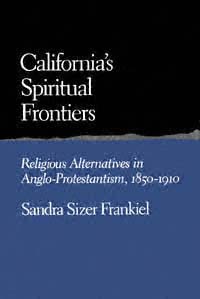 | Title: California's spiritual frontiers: religious alternatives in Anglo-Protestantism, 1850-1910 Author: Frankiel, Sandra Sizer 1946- Published: University of California Press, 1988 Subjects: History | Californian and Western History | California and the West | Christianity Publisher's Description: In this fascinating work, Frankiel examines California's rich, multi-faceted religious history during the period in which the state was taking shape on the American landscape. Similar Items |
| 20. |  | Title: To place our deeds: the African American community in Richmond, California, 1910-1963 Author: Moore, Shirley Ann Wilson 1947- Published: University of California Press, 2000 Subjects: History | Californian and Western History | California and the West | African American Studies Publisher's Description: To Place Our Deeds traces the development of the African American community in Richmond, California, a city on the San Francisco Bay. This readable, extremely well-researched social history, based on numerous oral histories, newspapers, and archival collections, is the first to examine the historical development of one black working-class community over a fifty-year period.Offering a gritty and engaging view of daily life in Richmond, Shirley Ann Wilson Moore examines the process and effect of migration, the rise of a black urban industrial workforce, and the dynamics of community development. She describes the culture that migrants brought with them - including music, food, religion, and sports - and shows how these traditions were adapted to new circumstances. Working-class African Americans in Richmond used their cultural venues - especially the city's legendary blues clubs - as staging grounds from which to challenge the racial status quo, with a steadfast determination not to be "Jim Crowed" in the Golden State.As this important work shows, working-class African Americans often stood at the forefront of the struggle for equality and were linked to larger political, social, and cultural currents that transformed the nation in the postwar period. [brief] Similar Items |